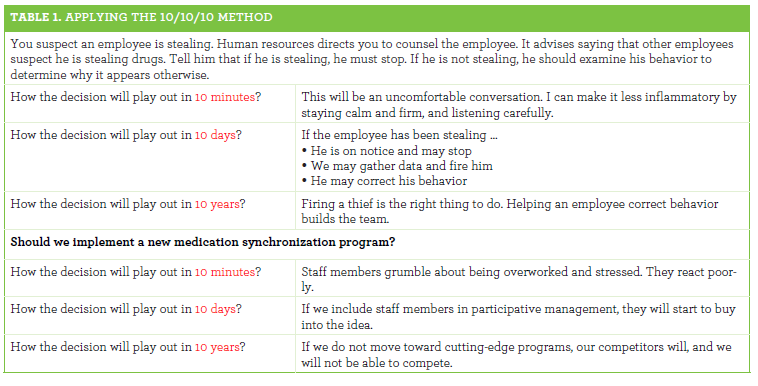Publication
Article
Pharmacy Times
Dealing with Gray Issues
Author(s):
Pharmacists often lead teams and must make difficult decisions.
In business and in life, humans can be indecisive. Pharmacists often lead teams and must make difficult decisions. Five techniques can reduce the human tendency toward indecisiveness and improve outcomes.

Narrow framing occurs when decision makers think about issues in inflexible ways and limit available options, or waiver in the gray areas between 2 options.1 Pharmacists should be able to quickly fix narrow framing in their thinking (Figure1,2), because we often use counseling techniques that fix patients’ narrow framing. We ask open-ended questions that do not allow yes or no answers, forcing patients to use more words to describe their situations.
Often, decision makers narrow themselves to 2 almost equally attractive (or distasteful) options. Experts advise trying to accomplish or avoid both, pursuing them simultaneously or in sequence, or developing a third and better approach. This is “multitracking.”2 If your goal is to boost profits, consider ways to increase profits and cut costs.
2. Combat confirmation bias. Warren Buffet credits Charles Darwin with saying that whenever something contradicted his belief system, Darwin recorded the new finding within 30 minutes. Otherwise, Darwin’s mind would reject the dissonant information, like the body rejects transplants.3 Too often, we seek information or interpret new information in ways that confirm our previously held beliefs.2,3
Pharmacists—often, the workplace team’s leaders and highest paid members—may subconsciously favor one solution and turn to team members who confirm their leanings. To avoid this pitfall, imitate Warren Buffet: confront confirmation bias by consulting your harshest critic.3 This is reality-testing using feedback from team members opposed to an idea. For example, if your team is considering hiring a job applicant who seems (to you) like a good fit, ask teammates why the person might be unsuitable. However, always ensure confidentiality or allow anonymous feedback so individuals will not feel threatened.
3. Recognize when emotion clouds decision-making ability. Distance yourself. Emotion can muddy thinking and lead to poor decisions (and unacceptable behavior).1,4 For example, your team may have invested countless hours in a new immunization campaign. However, on launch day, you are not ready. Your emotions say, “We planned this! Everyone will be disappointed. Launch the campaign!” Coolly, and with a level head, step back and engage logic: consider what is best for the campaign’s success. Or, a rude, lazy coworker asks for a favor that will better the organization and help patients. Override your negative emotions. Do the favor.
Placing potential outcomes on a timeline adds context to the decision. Table 1 demonstrates how to use the 10/10/10 method to address decisions.5

4. Think about potential outcomes. We frequently make the wrong decision. It might be what time to leave for work, what laundry detergent to buy, or which job to take. How can you reduce the likelihood of poor outcomes?
In most cases, wrong decisions are inconsequential, but when it comes to major decisions with major consequences, you will want to prepare for bad outcomes. Researchers advise decision makers to consider what could go right and to prepare to be wrong, before making major decisions (Table 2).2

5. Make every decision patient-driven. The science behind decision making and best practices, continually attracts scholars’ attention. This is the bottom line: always ask, “How will various decisions affect patients?” Patients are the reason we practice pharmacy.
Ms. Wick is a visiting professor at the University of Connecticut School of Pharmacy.
References
- Zhang M. 14 tricks to improve your decision making. Business Insider website. businessinsider.com/make-better-decisions-2014-7. Accessed March 14, 2016.
- Heath C, Heath D. Decisive: How to Make Better Choices in Life and Work. New York, NY: Crown Business Publishing; 2013.
- Dooley R. How Warren Buffett avoids getting trapped by confirmation bias. Forbes website. forbes.com/sites/rogerdooley/2013/05/07/buffett-confirmation-bias/#df3840f3a838. Accessed March 14, 2016.
- Soohoo A. Doing this will help you make better business decisions. Fortune website. fortune.com/2016/02/06/better-business-decisions. Accessed March 14, 2016.
- Welch S. 10-10-10: A Life-Transforming Idea. Southern Pines, NC: Scibner; 2009.







